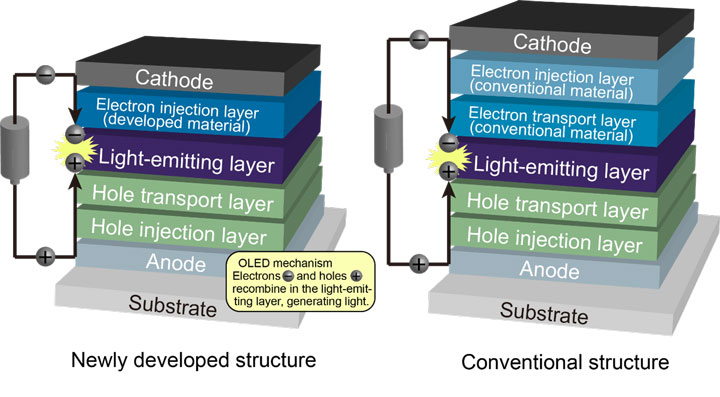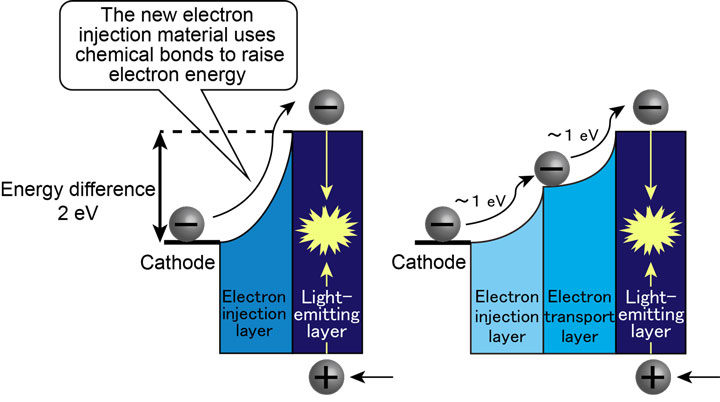

NHK:“弯曲”有机EL显示器:新材料开发
NHK科学技术研究实验室:
我们的目标是“实现可卷绕和折叠的大屏幕柔性显示器”。
NHK和Nippon Shokubai:
我们首次在世界范围内阐明了有机EL显示器的电子注入操作机理。
5月12日
NHK科学技术研究实验室与Nippon Shokubai合作
共同开发了一种新型的高性能电子注入材料。
OLED的特性:
在有机EL中
将电子注入发光层
在有机EL的阴极和发光层之间
必须使2eV的能量差为零。
最新开发的电子注入材料:
-实现零能量差-
借助新开发的电子注入材料
利用与阴极和有机材料的化学键
我们成功地将能量差减小到零。
新发现:
更多,
“常规有机EL /电子传输材料”比传输电子的作用更为重要。
相反,他还阐明了“将能量差降低约1 eV的作用很大”。
无需电子运输材料:
有了这些发现,“如果使用新的电子注入材料,则不需要电子传输材料”。
结果,可以将电子直接注入发光层中。
(Impress Watch)–Yahoo!新闻
https://news.yahoo.co.jp/articles/2fde5abd22c1cc7428e02c94a69d091b6a6ec15e
OLED Electron Injection Mechanism Explained
NHK Science & Technology Research Laboratories (NHK STRL)
is conducting R&D on organic light-emitting-diode (OLED)1) devices, with the goal of realizing flexible, large-screen displays that can be folded or rolled up.
To extend the lifetime of flexible displays and reduce power consumption,
NHK STRL has developed an electron injection layer (EIL) material, which injects electrons from the cathode into the light emitting layer2).
At this time, we give the first-ever explanation of the electron injection mechanism and have developed a new EIL material that will further improve performance*.
To inject electrons into the light-emitting layer in an OLED device,
the energy difference of approximately 2 eV between the cathode and the light-emitting layer must be reduced to zero.
We have explained, for the first time,
how the EIL material we have developed uses its chemical bonds with the neighboring material reduce this difference to zero.
We have also explained how the electron transport material used in conventional OLED devices
reduces this energy difference by approximately 1 eV, which is an even more important role than transporting the electrons.
These discoveries have shown that with the new EIL material, the electron transport material is no longer needed, and it can inject electrons directly into the light-emitting layer.
The new EIL material will contribute to extending the lifetime and reducing power consumption of OLED devices
and also simplify the structure of OLED devices, since the electron transport material is no longer needed.
These research results were published in the May 11 edition of Nature Communications.
We are continuing R&D to create flexible displays with longer lifetime and lower power consumption as soon as possible.
NHK STRL